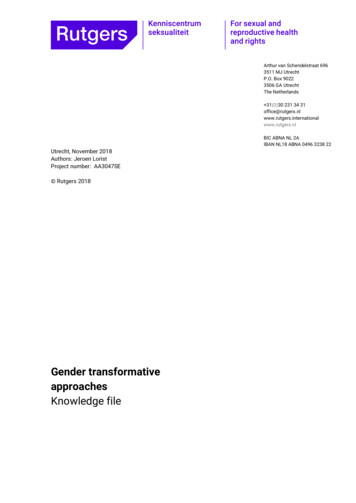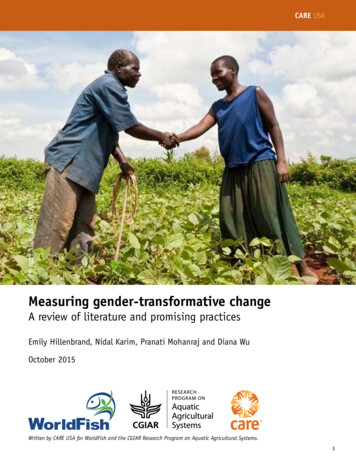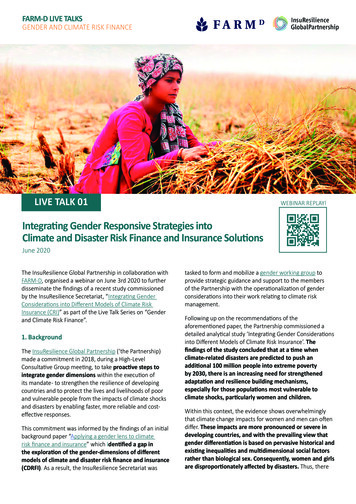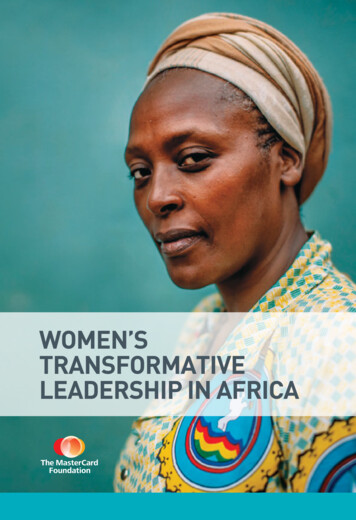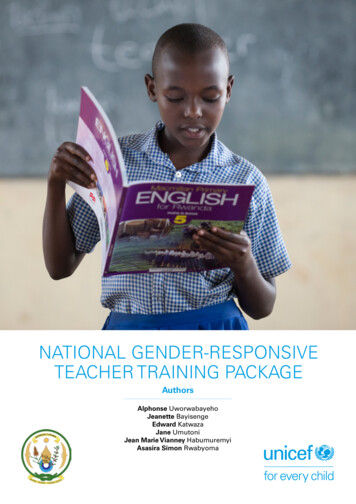
Transcription
Gender-Inclusive, -Responsiveand -Transformative AgriculturalInsurance: A Literature ReviewWorking Paper No. 417CGIAR Research Program on Climate Change,Agriculture and Food Security (CCAFS)Anne G. TimuBerber Kramer
Gender-Inclusive, -Responsiveand -TransformativeAgricultural Insurance: ALiterature ReviewWorking Paper No. 417CGIAR Research Program on Climate Change,Agriculture and Food Security (CCAFS)Anne G. TimuBerber Kramer2
Correct citation:Timu A., Kramer B. 2021. Gender-Inclusive, -Responsive and -Transformative Agricultural Insurance:A Literature Review. CCAFS Working Paper no. 417. Wageningen, the Netherlands: CGIAR ResearchProgram on Climate Change, Agriculture and Food Security (CCAFS).Titles in this series aim to disseminate interim climate change, agriculture and food security researchand practices and stimulate feedback from the scientific community.The CGIAR Research Program on Climate Change, Agriculture and Food Security (CCAFS) is led bythe International Center for Tropical Agriculture (CIAT) and carried out with support from theCGIAR Trust Fund and through bilateral funding agreements. For more information, please visithttps://ccafs.cgiar.org/donors.Contact:CCAFS Program Management Unit, Wageningen University & Research, Lumen building,Droevendaalsesteeg 3a, 6708 PB Wageningen, the Netherlands. Email: ccafs@cgiar.orgThis Working Paper is licensed under a Creative Commons Attribution – NonCommercial 4.0International License. 2021 CGIAR Research Program on Climate Change, Agriculture and Food Security (CCAFS).CCAFS Working Paper no. 417DISCLAIMER:This Working Paper has been prepared as an output for the Climate Services and Safety Nets Flagshipunder the CCAFS program, the CGIAR Research Program on Policies, Institutions, and Markets (PIM)led by the International Food Policy Research Institute (IFPRI), and has not been peer reviewed. Anyopinions stated herein are those of the author(s) and do not necessarily reflect the policies or opinionsof CCAFS, PIM, IFPRI, donor agencies, or partners.3
AbstractThis literature review uses a gender analysis framework proposed byJohnson et al. (2018) to explore the extent to which agricultural insurancereaches, benefits and empowers women and men. We find that moststudies on gender and agricultural insurance focus on gender inclusivity byanalyzing gender gaps in insurance reach and studying how to increasetake-up among women. By contrast, limited attention has been paid tounderstanding gender equity in the distribution of insurance outcomes, thatis, the extent to which insurance benefits and empowers women as much asmen. We show that insurance programs can promote gender equity inbenefits by providing quality insurance products that are beneficial to bothmen and women, and through long-term monitoring of individual outcomesmeasured within households using gender-disaggregated data. Insuranceprograms can support gender empowerment by ensuring that contractspurchased by women are registered under their names and payouts aresubsequently paid to their accounts, by bundling insurance withempowerment programs, and by preserving and promoting informal mutualassistance group activities and membership. We then draw on a case studyin Kenya to illustrate how this framework can be applied to design moregender-inclusive, -responsive and -transformative insurance schemes.KeywordsAgricultural insurance; Gender; Empowerment; Literature Review; Kenya4
About the authorsAnne G. Timu (annegesare@gmail.com) is a Research Consultant in theMarkets, Trade and Institutions Division of the International Food PolicyResearch Institute (IFPRI).Berber Kramer (b.kramer@cgiar.org) is a Senior Research Fellow inIFPRI’s Markets, Trade and Institutions Division in Nairobi, Kenya.5
AcknowledgementsWe are grateful to Peter Hazell, Francisco Ceballos, Harold Aldermanand Neha Kumar for the collaboration that inspired the writing of thispaper, and to Samyuktha Kannan for comments on an earlier draft.This work was undertaken as part of the CGIAR Research Program onPolicies, Institutions and Markets (PIM), led by the International FoodPolicy Research Institute (IFPRI), and the CGIAR Research Program onClimate Change, Agriculture and Food Security (CCAFS). Fundingsupport for this study was provided by CCAFS and PIM. This paper hasnot gone through IFPRI’s standard peer-review procedure. Theopinions expressed here belong to the authors, and do not necessarilyreflect those of CCAFS, PIM, IFPRI, or CGIAR.6
Contents1.Introduction82. Framework for analyzing gender impacts of agricultural developmentinterventions113. Gender Dimensions of Agricultural Insurance153.1. Agricultural Insurance Reach153.2. Gendered Distribution of Costs and Benefits of AgriculturalInsurance3.3. Agricultural Insurance and Gender Gaps in Empowerment4. Case Study5. 4.1. Addressing Gender Equity in Insurance Reach192124256.4.2 Addressing Gender Equity in the Distribution of Insurance Benefits274.3. Addressing gender equity and women empowerment29Conclusion32References367
IntroductionIn most rural areas of developing countries, women farmers face a hostof social, institutional, and economic constraints that increase theirvulnerability to climate-related production and income shocks. First,compared to men, women tend to own and control fewer productiveassets, including land and livestock (Quisumbing et al. 2015), limitingopportunities to diversify risks and cope with shocks. Second, theyspend an important part of their day on domestic, reproductive roles,and unpaid care work, reducing their mobility and access to importantagricultural services (Ferrant et al. 2014), which could help invest inrisk-mitigating practices and technologies. Third, systematic genderbiases in parental allocation of intra-household resources includingeducational investments constrain women’s economic opportunities(Behrman et al. 1997), and thus their ability to manage risks. Althoughinformal mutual assistance groups have been shown to be relativelyeffective in helping women and other poor households manage risks (diFalco and Bulte, 2013), such arrangements do not function effectivelyfor covariate climatic shocks that affect all community members at thesame time (Alderman and Haque, 2007). These factors expose womento chronic economic and social repercussions associated with climaticuncertainties.In recent decades, there has been a growing interest in the use ofagricultural insurance as a tool to manage covariate risks related toclimate and weather uncertainties. Between 2007 and 2019, the valueof agricultural insurance premiums sold globally grew from US 20billion to US 30 billion (Mahul and Stutley, 2010; Swiss Re, 2019).Interest in agricultural insurance stems from its potential impact inproviding financial protection to poor rural households, helping thempreserve their productive assets and maintain consumption in the faceof climatic shocks (Janzen and Carter, 2019). Agricultural insurancealso enables farmers to take on more risks ex ante and increaseinvestment in their farms despite the anticipation of crop or livestocklosses in the face of a possible weather event (Karlan et al. 2014;Jensen et al. 2017). Insurance might further serve as a substitute forcollateral, improving access to formal and informal credit and enablingfarmers to purchase modern farm inputs and productive assets to8
improve their farm productivity and incomes over time (Farrin andMiranda, 2015). Improved farm productivity can in turn lead to lowerfood prices benefiting consumers (Hazell and Varangis, 2020) andreduce government expenditure on safety-nets (Janzen et al. 2021)which offers a longer-term ‘win-win’ solution.A few studies however indicate that the long-term effects of insuranceon household well-being are rather weak (Tobacman et al. 2017) andinsurance benefits are skewed to wealthier farmers—who are morelikely to be men (Glauber 2012). Failing to acknowledge genderinequities in the distribution of insurance outcomes can limit the longterm effectiveness of insurance as a risk-coping strategy. This papertherefore reviews the available evidence on how to create genderequity within the context of agricultural insurance schemes, focusingon three sets of outcomes: whether insurance is gender inclusive,gender responsive, and gender transformative.Most gender-based studies have evaluated ways to make insurancegender-inclusive, and ensure that it reaches both men and women,both in terms of their awareness of the possibility and ways to enrollin insurance and eliminating gender gaps in actual enrollment intoinsurance schemes (Fletschner and Kenney 2011; IFAD 2020; Greatrexand Huyer 2020). However, more recent literature argues that genderapproaches in agriculture development projects should move beyondinclusion to integrate facets of gender-responsive and ramconceptualization, development, implementation, and evaluation(Johnson et al. 2018). Gender-responsive approaches understandmen’s and women’s different needs and interests and make deliberateefforts to ensure that programs equitably benefit both men andwomen, without harming either gender (Valencia, 2021), but suchapproaches do not deliberately challenge unequal power relations inthe society (Johnson et al. 2018). By contrast, gender transformativeapproaches explicitly engage both women and men to examine,question, and change the institutions and norms that reinforce genderinequalities promote positions of social and political influence forwomen in communities, and address power inequities. Such approachestake the burden of change off women, recognizing that gender equalityis the responsibility of everyone (World Economic Forum, 2021).9
Although few studies have considered how agricultural insurance couldreinforce issues of gender inequalities (Fisher et al. 2018; Reeves2017), the studies have narrowly focused on inequities in design anddelivery mechanisms. We however expect that agricultural insurancewill have far-reaching impacts on intrahousehold dynamics such aslabor allocation, market integration, resource use and allocation,among others. As such, it is important to understand the genderdimensions of agricultural insurance beyond design and deliverymechanisms. Our study seeks to contribute to this literature byanswering the following two questions: i) How are insurance outcomesdistributed among men and women in the society? And ii) How caninsurance practitioners design products and programs that are genderinclusive, gender-responsive, and gender-transformative, so thatinsurance reaches, benefits and empowers men and women alike?To answer these questions, this literature review applies a frameworkfor analyzing gender outcomes of agricultural development programs(Johnson et al., 2018) to conduct a comprehensive evaluation of thedistribution of insurance outcomes for women and men. We also drawon a case study in Kenya to illustrate how insurance programs can betweaked to become more gender-inclusive, -responsive and transformative. We find that most studies on gender and agriculturalinsurance focus on gender inclusivity, and that less attention has beenpaid to understanding gender equity in the distribution of insuranceoutcomes. Our review shows that insurance programs can be genderinclusive and promote insurance reach in both women and men byaddressing both demand- and supply-side constraints to uptake. Wealso find that the provision of quality products through bundlingcomplementary risk management strategies, and long-term monitoringof individual outcomes can be a gender-responsive approach ofimproving insurance benefits to both men and women. Finally, we showevidence that insurance can be gender-transformative and supportwomen empowerment by ensuring that contracts purchased by womenare registered under their names and payouts are subsequently paid totheir accounts, by bundling insurance with gender empowermentprograms, and by preserving and promoting informal mutual assistancegroup activities and membership.10
The remainder of the paper is structured as follows. First, section 2provides a framework for evaluating gender impacts and analyzing thedistribution of agricultural insurance outcomes. Next, section 3provides an application of the framework to review gender equity inthe existing literature on agricultural insurance programs fordevelopment. Section 4 provides case studies based on insuranceresearch in Kenya, and finally, section 5 concludes with a discussion ofour findings.Framework for analyzing gender impacts ofagricultural development interventionsIn this section, we discuss how gender intersects with agriculturalinsurance, using a framework by Johnson et al. (2018) for analyzinggender impacts of agricultural development interventions. Theframework acknowledges that a gender approach requires lookingbeyond the stated objective to the set of activities the projectundertakes, the possible gender outcomes and impacts of theseactivities, and the indicators through which it proposes to measurethese outcomes and impacts. The framework proposes three distinctapproaches to achieving and evaluating gender impacts (see Figure 1):reach (the extent to which a program is gender inclusive), benefits(gender responsive), and empowerment (gender transformative).11
ude women in programsactivitiesIncrease women’s wellbeinge.g. health, food security,resilience etc.Strengthen the abilityof women to makestrategic life choiceand to put thosechoices into actionStrategyStrategyStrategyInviting women as participants,seeking to reduce barriers toparticipation, implementing aquota system for participation intraining eventsDesigning a project to considergender needs, preferences,and constraints to ensure thatwomen benefit from theproject activitiesEnhancing women’sdecision-makingpower in household,and communitiesIndicatorsIndicatorsIndicatorsNumber or proportion of womenparticipants in a projectactivity, e.g. attending training,using the product, receivingextension advice etc.Sex-disaggregated data forpositive and/or negativeoutcomes such as productivity,income, assets, nutrition, timeuse etc.Women’s decisionmaking power.Reduction ofoutcomes associatedwith disempowerment.Figure 1: Project Approaches to Women. Source: Johnson et al. (2018)Johnson et al. (2018) describe reach as including women as participantsin program activities and tracking their progress over time. Theprogram can also track the percent of women with access to extension,training materials or any other services supported by the project. Theyrecommend that programs ensure women participation through raintstoparticipation—for example changing time and place for meetings,forming women-only groups, hiring women staff in implementingorganizations, and having a minimum requirement for womenparticipation. However, reaching women is not always sufficient forgender inclusion. Theis and Meinzen-Dick (2016) show that whilecounting and facilitating women’s participation is important, programsthat only record the number of female participants may miss importantintrahousehold and community dynamics that might still preventcertain groups of women from participating. Moreover, even whenreaching women in an inclusive way, a program may still dilute orredistribute program benefits away from women. For example, a12
program might create the unintended consequence of increasingwomen’s time burdens.The benefit component of this framework argues that the projectdesign, implementation, and evaluation should be focused on ensuringthat whatever outcomes the project is seeking—reduced hunger,increased health and income, greater resilience—are captured andvalued by both men and women, and that a program does not harmeither of them. This requires considering both women’s and men’sneeds and const
insurance practitioners design products and programs that are gender-inclusive, gender-responsive, and gender-transformative, so that insurance reaches, benefits and empowers men and women alike? To answer these questions, this literature review applies a framework for analyzing gender outcomes of agricultural development programs


